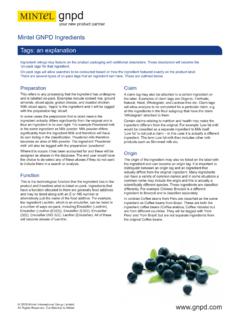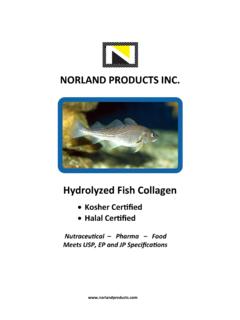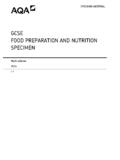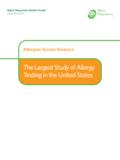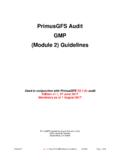Transcription of The Herbal Database A listing of herbs, spices, and ...
1 The Herbal Database a listing of herbs, spices, and medicinal plants & some clues to their uses by George Wooten, 1998-2008. Dedication The Herbal Database is dedicated to the tea plant, used medicinally, nutritionally, through folklore, and as a Camellia sinensis, the source of commercial tea. It beautiful ornamental, in addition to its worldwide embodies the quintessence of Herbal products, being importance as a stimulant. Summary The Herbal Database is a dictionary of botanical products fields for parts used, Latin name(s), botanical family, used as herbs, spices, medicinals, dyes, charms, and uses, and constituents.
2 The Herbal Database includes a foods. The Database alphabetically lists botanicals in a glossary of terms, an index and a reference bibliography. table by the most commonly used name, followed by How to use the Herbal Database Disclaimer: The Herbal Database is a listing of natural, Field 1, common name. This field lists natural products primarily plant, products and some of their properties, alphabetically, by commonly used names. The products whether safe or toxic, real or imagined. This Database listed were chosen to be representative of commonly was developed purely for informational purposes only, available, poisonous, special-interest, or important and does not in any way purport to be a medical or medicinal plants with a few products representing dyes, prescriptive guide.
3 As such, the authors and publishers animal, insect, or mineral products. Common, generally absolve themselves of all responsibility for any accidental English, names were used as key fields, rather than or intended harmful effects or illegal activities resulting scientific names, because most interest in this project from the use or abuse of any of these products. appeared to be lay, rather than scientific, however the index cross-references the products by other common Each herb, spice, medicinal, or botanical is contained in names and Latin binomial.
4 Six fields that describe some of its most notable properties. The entire set of data is available in both Field 2, parts used. This field contains the part of the printed form for appearance, and as a computer natural product normally used. Database , for easy searches. Rather than being a comprehensive Database of every natural product in the Field 3, scientific Latin binomial name, including world, the project is designed to be informative, commonly used synonyms (in parentheses when educational and interesting, thus products included positively out-dated), and closely related species within represent those that are most commonly available, the genus.
5 Familiar, useful, or interesting. Part of this project involved deciding which products to include or not. For instance, Field 4, plant family, in botanical Latin. The common some products were excluded because they were rare, names of the approximately 90 families represented are endangered, extremely poisonous, merely nutritive, or given in the glossary. primarily used in arts, crafts, or as charms. Field 5, properties and uses. This field summarizes some Any suggestions, hints or additions on the Database notable properties, derivatives and uses of the natural structure or products included or excluded are welcomed.
6 Product, reputed or actual. Many historical uses are Copies of this Database are available as hard copy folkloric or based on use of the plant as a talisman, or printouts, or on diskette (in the following IBM PC formats: because of its physical form (the doctrine of signatures, in Word for Windows , Windows Write, Word Perfect ). Old English usage, believed that the shape of a plant was For postpaid orders, send $ for the printout or an indicator of the body part it was useful for). Qualities diskette ( for both) to the author, George Wooten, listed are the best fits of literature searches, as data may Floradora Farms, PO Box 1099, Winthrop, WA 98862.
7 Have been scant, lacking, or ambiguous. Documented unpleasant or dangerous side effects were included if known, however unknown long-term effects or individual 2. allergic effects could not always be anticipated and noted. Field 6, chemical constituents. This field lists the names of No medical recommendations or claims are made for any some of the known chemical constituents. Constituents, of these plants; as such the term agent is used when known, were those chemicals responsible for the preferentially to remedy or cure. listed effects, or the most potent chemicals, or those chemicals found in highest quantities in the natural product.
8 Glossary The following short glossary lists some of the terms, conventions and abbreviations used here. This glossary is not meant to be comprehensive, only helpful. abortifacient: an agent that can induce abortions. bradycardia: a slowed heartbeat. alkaloid: a nitrogenous, basic, and often medicinal, plant C-5, C-10,..: used to denote number of carbon atoms. compound. carcinogen: a substance that predisposes cancer allergen: a compound that produces an allergic reaction. development. alterative: a compound that alters body metabolism.
9 Carminative: a substance to relieve the body of excess analeptic: a restorative. gas. analgesic: an agent that relieves pain. catalyst: a preparation that makes other remedies more anodyne: an agent that relieves pain through reducing effective. nerve excitability. cathartic: see purgative. anthelmintic: a preparation to rid the body of worms. cholagogue: an agent to promote flow of bile into small anthraquinones: a ketonic tricyclic anthracenes with intestine. laxative action. CNS: abbreviation for central nervous system. anti-: prefix for terms designating amelioration, relief, or depressant, CNS: a compound that reduces mental removal.
10 Function. antiacid: an agent to relieve excess stomach, blood or coumarins: bicyclic, aromatic molecules that antagonize bowel acidity. vitamin K. antiasthmatic: an agent to dilate bronchioles or break up CV: abbreviation for cardiovascular. mucus. decoction: a boiled extract, used for the preparation of antibiotic: an agent to inhibit growth of, or destroy, roots. bacteria. decongestant: an agent to relieve nasal congestion. anticarcinogen: an agent to counteract cancer. demulcent: a compound that protects abraded tissues. anticatarrhal: an agent to counteract mucus formation.

